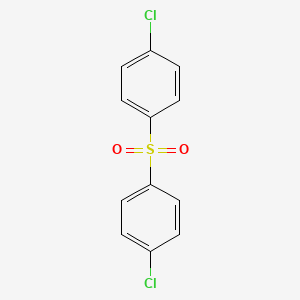D0716 | 4,4'-dichlorodiphenyl sulfone
| Toxicity | Dose | Time | Species | Model | Method | Action | Positive criterion | Reference |
|---|---|---|---|---|---|---|---|---|
| MEMBRANE POTENTIAL | 21.27±6.06 | human | qHTS-HepG2 | MMP assay | decrease | IC50 | 163 | |
| MEMBRANE POTENTIAL | 35.48 | human | HepG2 | MMP assay | decrease | IC50 | 163 | |
| MEMBRANE POTENTIAL | 29.90±2.43 | rat | hepatocytes | MMP assay | decrease | IC50 | 163 | |
| Pictogram | Signal | Statements | Precautionary Statement Codes |
|---|---|---|---|
  |
Warning |
Aggregated GHS information provided by 248 companies from 6 notifications to the ECHA C&L Inventory. Each notification may be associated with multiple companies. Reported as not meeting GHS hazard criteria by 101 of 248 companies. For more detailed information, please visit ECHA C&L website Of the 4 notification(s) provided by 147 of 248 companies with hazard statement code(s): H319 (93.88%): Causes serious eye irritation [Warning Serious eye damage/eye irritation] H411 (85.03%): Toxic to aquatic life with long lasting effects [Hazardous to the aquatic environment, long-term hazard] Information may vary between notifications depending on impurities, additives, and other factors. The percentage value in parenthesis indicates the notified classification ratio from companies that provide hazard codes. Only hazard codes with percentage values above 10% are shown. |
P264, P273, P280, P305+P351+P338, P337+P313, P391, and P501; (The corresponding statement to each P-code can be found at the GHS Classification page.) |
| Organism | Test type | Route | Dose (normalized dose) | Effect | Source |
|---|---|---|---|---|---|
| mouse | LD50 | oral | 24gm/kg (24000mg/kg) | behavioral: tremor | Helvetica Chimica Acta. Vol. 29, Pg. 1317, 1946. |
| rat | LDLo | oral | 7500mg/kg (7500mg/kg) | gastrointestinal: "hypermotility, diarrhea" | National Technical Information Service. Vol. OTS0533718, |
| 1,1'-Sulfonylbis(4-chlorobenzene) | 1-Chloro-4-[(4-chlorophenyl)sulfonyl]benzene | 1-Chloro-4-[(4-chlorophenyl)sulfonyl]benzene # |
| 1-chloro-4-(4-chlorobenzenesulfonyl)benzene | 1-chloro-4-(4-chlorophenyl)sulfonyl-benzene | 4,4'-DICHLORODIPHENYL SULFONE |
| 4,4'-Dichlorodiphenyl sulfone (4,4'-DCDPS) | 4,4'-Dichlorodiphenyl sulfone, 97% | 4,4'-Dichlorodiphenyl sulphone |
| 4,4'-Dichlorodiphenyl sulphone (4,4'-DCDPS) | 4,4'-Dichlorodiphenylsulfone | 4,4'-Dichlorophenyl sulfone |
| 4,4'-sulfonylbis(chlorobenzene) | 4,4[-Dichlorodiphenyl sulphone] | 4-Chloro-1-(4-chlorophenylsulfonyl)benzene |
| 4-Chlorophenyl sulfone | 4-chloro-1-[(4-chlorophenyl)sulfonyl]benzene | 5U49794253 |
| 80-07-9 | AB0007498 | AE-848/30709029 |
| AI3-01386 | AI3-02901 | AK393212 |
| AKOS001053313 | ANW-42349 | B0810 |
| BBL000098 | BRN 2052955 | Benzene, 1,1'-sulfonylbis(4-chloro- |
| Benzene, 1,1'-sulfonylbis[4-chloro- | Benzene,1'-sulfonylbis[4-chloro- | Bis(4-chlorophenyl) sulfone |
| Bis(4-chlorophenyl) sulfone, 98% | Bis(4-chlorophenyl) sulphone | Bis(4-chlorophenyl)sulphone |
| Bis(p-chlorophenyl) sulfone | CAS-80-07-9 | CCRIS 8813 |
| CHEMBL1334784 | CTK3E8067 | DB-056405 |
| DS-13151 | DSSTox_CID_4986 | DSSTox_GSID_24986 |
| DSSTox_RID_77613 | DTXSID9024986 | Di-p-chlorophenyl sulfone |
| EC 201-247-9 | EINECS 201-247-9 | F0701-0150 |
| FT-0617041 | GPAPPPVRLPGFEQ-UHFFFAOYSA-N | HMS3039H07 |
| HSDB 5233 | InChI=1/C12H8Cl2O2S/c13-9-1-5-11(6-2-9)17(15,16)12-7-3-10(14)4-8-12/h1-8; | KS-00000NU0 |
| KSC448A6P | LS-1789 | LS41218 |
| MCULE-4699062729 | MFCD00000619 | MLS001065613 |
| NCGC00090750-01 | NCGC00090750-02 | NCGC00090750-03 |
| NCGC00090750-04 | NCGC00090750-05 | NSC 23899 |
| NSC-23899 | NSC-38759 | NSC-50730 |
| NSC-7207 | NSC23899 | NSC38759 |
| NSC50730 | NSC7207 | Q4637049 |
| RTR-025381 | SBB059046 | SCHEMBL22742 |
| SMR000568488 | ST45133164 | STK279748 |
| Sulfone, bis(p-chlorophenyl) | T6979 | TR-025381 |
| Tox21_400008 | UNII-5U49794253 | W-104252 |
| WLN: GR DSWR DG | ZINC388307 | bis(4-chlorophenyl)sulfone |
| p,p'-Dichlorodiphenyl sulfone | p-Chlorophenyl sulfone |
| CAS Number | 25154-01-2, 80-07-9, 91294-83-6 |
| PubChem Compound | 6625 |

